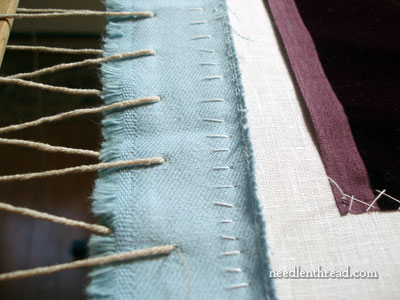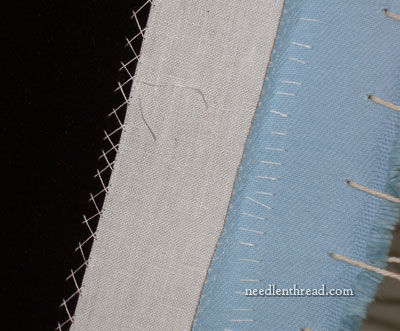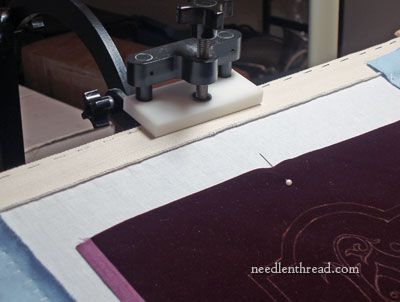Yesterday morning, I finished setting up a slate frame for my little goldwork class. Having run out of twill tape, cotton webbing, and any other stuff pre-made into sturdy strips that I could sew onto the sides of the linen for lacing the frame, I had to improvise.

When dressing a slate frame, you can manage the sides a couple ways. You can double-fold the edge of your ground fabric, like I did in this tutorial on dressing a slate frame, or you can sew extra strips of strong fabric tape (like cotton twill tape or cotton webbing) onto the sides of your fabric, and lace through the strips. Both ways are described in different books that touch on the subject of dressing a slate frame, and both ways work.
Because of the type of linen I’m using on this current class project and the smaller size of the project, I decided to go for the side-strip method. But I didn’t have any strips of anything on hand. And since the town I live in is one of those “geographical oddities” (40 miles from everywhere!), I decided to rummage through the cupboards and come up with another solution.
Really, any relatively strong fabric would do, but I didn’t want to use a more expensive linen or a too-flimsy cotton muslin. Aha! Perfect! I found a length of cotton twill fabric hiding in a fabric bin. I haven’t touched the stuff for years, and I can’t even remember why I have it. But – finally – its Moment to Shine arrived! I cut two-inch strips along the selvedge, used the overlock on my sewing machine to finish the unfinished edge of the strips, and had my tape!

It really worked like a dream. And the fact that it’s blue doesn’t bother me at all, either.

And another happy thing I discovered about the slate frame for this project: it gets along quite well with my Needlework System 4 stand. (That’s a link to my review.) I’d call the slate frame medium-large. The tapes are about 16″ wide on the roller bars, and the side slats are about 20″ or 22″ long. It’s not a little frame, but it isn’t “huge” either. And the stand with the frame clamp holds it just fine.
Now the project’s ready for the fun part – the stitching! I’ll let you know how we get on!







Mary: How would you compare Evertite frames to slate frames? Can they each generate the same degree of tightness, or are slate frames tighter than Evertites? Janet.
Hi, Janet & Carolyn –
Evertites are great. I love them. I use them more often than I do slate frames, because slate frames do take so much more time and effort to set up. As for tension, I think you get the best tension from the slate frame, and it is, in a sense, “infinitely” adjustable on a given project. You can keep tightening the sides by adjusting the lacing, and the top & bottom edges by moving the pegs or by rolling the work if you need to. But for most projects, the Evertites works just fine, and they are as adjustable as I generally need. However, eventually, you do run out of “adjustment” space with the Evertites. This has only happened to me once, when I had a project set up over a year on the Evertites, and had varying weather conditions (humidity affects the fabric while it’s on the frame). In that case, I removed the project from the frame, tightened the inset screws back up to their original position, remounted the fabric, and then had room again for stretching it out to very taut. But in most cases, I don’t leave a project on the frame that long, and so the Evertites work great for most projects.
Why the slate frame for this, vs. the Evertites? I chose a slate frame because of the type of project. The linen is acting as the lining for the project, so I set it up in the frame first, before mounting the velvet to the linen, before the final lacing. This ensured that the velvet was stretched smooth on the linen, with no buckling or ripples. The project will also be set up on a frame for quite a while, so I really wanted that “infinite” ability to tighten things up if necessary. Finally, I wanted to teach this student how to use a slate frame, since it really is “the” original embroidery frame, and it will be helpful for her to know how to set up her own. We worked with Evertites on our sample stitching, so she now knows how to set up a project on stretcher bars, and how to set up a project on a slate frame.
All that being said, what it boils down to is that Evertites do give very good, adjustable tension, and you can get your fabric “drum tight” with them. They are much easier and less intensive – time and work-wise – to set up, compared to a slate frame!!
There’s great satisfaction, though, in dressing a slate frame. When you’ve finished, you feel like you’ve scaled a mountain! 🙂
MC
I’ve read your review of the Evertite frame and have recently purchased one (hurry up and get here for Pete’s Sake!) and was wondering how you decide which to use – the traditional slate frame or your Evertite. I’ve picked the Evertite as my first one because of the ease of setting it up. I’ve been hesitant with a traditional one because it just looks to be so fiddle-y to set up.
Mary, why are they called slate frames? Until I followed the link to Hedgehog, I couldn’t imagine how one would make a frame of slate…but they’re wood.
Hi, Faith – Well, that’s a debatable point. The explanation I’ve ever seen in books is that it “might” come from the “slats” (the side bars of the frames) and it just sort of evolved into “slate”…. MC
Ok, I have to ask, where does the term Slate frame come from.. I kept looking for a piece of slate. 🙂 Ellen
That’s one of those historical questions that no one has a definite answer to, Ellen. Some claim (and it seems to make sense) that it morphed from “slat” (referring to the side slats on the frame) to “slate” with the evolution of the language and spelling, especially from the Middle Ages onwards.